|
Lost Buildings of Wolverhampton |
Some Congregational Churches
The pictures and information on this page are taken from the book
"Queen Street Congregational Church, Wolverhampton: the Story of a
Hundred Years 1809-1909" by Henry Arthur May. The book is dated 1909 but
no publisher is given - presumably it was published by the church
itself. The book contains many other photos, including some of the
interiors of these buildings, other churches in other parts of the area
and many of ministers. (It also contains much biographical information
about Wulfrunians of the Victorian age).
I have also used "History of the Congregational Churches of
Wolverhampton from the year 1662 to 1894" by Alderman W. H. Jones,
published by Alexander and Shepherd, London, 1894. May's book deals
mainly with the Queen Street Church; Jones's book deals mainly with the
Snow Hill church.
|
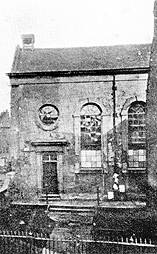 |
The first building used by nonconformists in Wolverhampton was the
John Street Meeting House, St. John's Lane. Built in 1701. This chapel was built to serve all non-conforming
people in town and continued in general use until the Socinian split
occurred. Then the Unitarians stayed in St. John's Lane and the
Trinitarian group seceded, setting up a meeting house in a converted
barn in Pounteney's Fold off Dudley Street.
In 1782 they built a new
church in Grey Pea Walk (later Temple Street) to which the majority of
the congregation moved. It was that church and congregation which later
built and moved into the Congregational Church on Snow Hill. The
minority stayed in Pountney's fold until 1800 when they built a new
chapel in Princess Street. |
| This church seems to have been very successful and by
1812 the building was too small. As to the fate of the building and its
site, May writes: "The meeting-house in Princess Street, with the
exception of the woodwork, which was used up in the new building, was
sold to Mr. John Mander for £400 in aid of the new chapel.
The Princess
Street premises afterwards became the public offices, where the 'town
commissioners' and the 'justices of the peace' transacted their business
on their removal from Lichfield Street, and before occupying the
premises in Garrick Street now used as Technical Schools.
Afterwards
Messrs. Crowley, Chaplin & Horne used the premises in connection with
their business as carriers. In later years the premises were converted
into the printing offices of the Chronicle and Express
newspapers. Now the site is covered by the premises of Mr. W. Gibbons,
printer." |
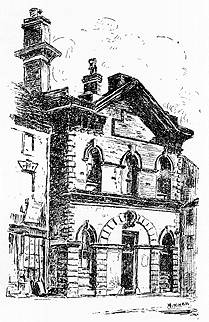
Princess Street Congregational Church. Built
1800. Architect unknown. Sketch by A. Bradney Mitchell. |
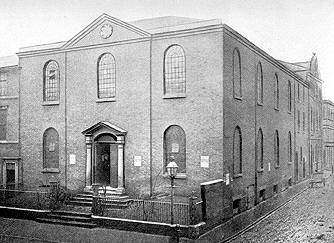
Queen Street Congregational Chapel 1813-1863.
Architect unknown. |
The church then built a bigger and better chapel on a
new site. Of this building May writes:
"In the summer of 1812
Mr. John Mander secured for them a plot of land at the corner of Queen
Street and Market Street. All down Queen Street, on that side, was then
garden ground. On the other side were private residences, the largest of
these being the residence of Mr. Cooper, a factor, whose warehouses were
at the back and fronted Princess Alley. Mr. Cooper's residence is now
the office of the Midland Evening News". |
May also records: "In order to lighten the burden of finance, Mr.
John Mander retained the basement of the new building. Subsequently this
came into unsympathetic hands, and to the scandal of the church, was let
for storing wine and spirits. At the side of the chapel in Market
Street, there was a large rolling way for the purpose of taking casks
and barrels in and out of the cellar. One morning it was found that a
wag had written on the cellar doors the following lines:
There are spirits above and spirits below;
There are spirits of joy and spirits of woe.
The spirits above are spirits divine;
The spirits below are spirits of wine." |
In 1862 it was decided that this building was too small.
The congregation worshipped in the Corn Exchange while a new
church was built. |
| The new church, Queen Street Congregational Church was built
in 1864-1866 by Trow & Sons, of Wednesbury. The architect
was George Bidlake. The foundation stone was laid on 28th June 1864 by Mr.
Thomas Wilkinson Shaw, who then jumped up on it and delivered a lengthy
address. The church was opened for worship on the 9th January 1866.
Pevsner says: "Grand, of ashlar, with a corner steeple. Free Italian,
but in the long side to Princess Street with its two tiers of triple
arched windows remarkably independent". And a footnote reads: "The
church has now been pulled down - Wolverhampton's loss".
|
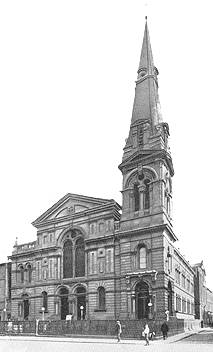
Queen Street Congregational Church. |
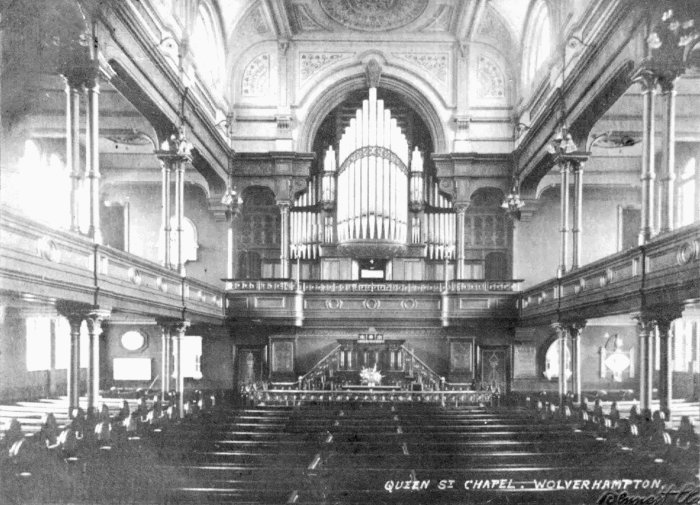
The interior of the church in about 1910. From
an old postard.
| The Congregational community at Temple Street increased in numbers
under the energetic Rev. W H Heudebourck and, at his urging, decided, in
1846, to build a new church. They continued with the project despite the
sudden departure of their pastor. The land on Snow Hill was bought from
the Duke of Cleveland at £1 per square yard and Edward Banks was
appointed as architect.
Work on the new chapel, and its associated schools,
proceeded throughout the severe depression of 1847. The
Schools were completed by July 1848 and duly opened, with a
tea-meeting on the first floor. During the proceedings it
was noticed that "the floor in the centre was sinking into a
kind of dish shape about six inches deep". Everyone fled to
the sides and stood there while the floor was propped up
from below. |

Snow Hill Congregational Church built
in 1849. Architect,
Edward Banks. |
| Then "the people looked at the centre but did not attempt
to move. Messrs. John Barker, Adams and Derry took chairs and placed
them in the centre space and began to have tea, and tried to look happy,
but the people were still afraid". So the pastor got everyone to sing a
hymn: "Children, will you go with me/To yon bright world". Perhaps a
strange choice but, fortified, no doubt, by the prospect of either
getting their tea or making a sudden descent into yon bright world, via
the floorboards, people started to move about again. Later the floor was
reinforced. (Local confidence in Edward Banks remained high. He built a
lot more buildings). The church itself was dedicated on July 31st 1849, a proceeding which
passed off without incident.
|
 |
Return to
the
previous page |
|